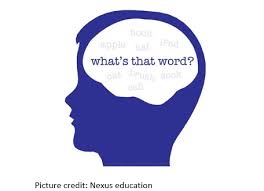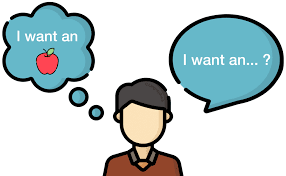
 Anomic aphasia is a mild, fluent type of aphasia where individuals have word retrieval failures and cannot express the words they want to say, particularly nouns and verbs.
Anomic aphasia is a mild, fluent type of aphasia where individuals have word retrieval failures and cannot express the words they want to say, particularly nouns and verbs.
Anomia is a deficit of expressive language, and a symptom of all forms of aphasia.
Anomic aphasia is a type of aphasia characterized by problems recalling words, names, and numbers.
Speech is fluent and receptive language is not impaired in someone with anomic aphasia.
Patients whose primary deficit is word retrieval have anomic aphasia.
Patients with anomic aphasia have relatively preserved speech fluency, repetition, comprehension, and grammatical speech.
Word selection anomia is caused by damage to the posterior inferior temporal area.
With this type of anomia the patient may know how to use an object and can correctly select the target object from a group of objects, and yet cannot name the object.
Some patients have word selection anomia and exhibit selective impairment in naming particular types of objects, such as animals or colors.
Color anomia, occurs when one can distinguish between colors but cannot identify them by name or name the color of an object.
Semantic anomia a disorder in which the meaning of words becomes lost is caused by damage to the angular gyrus.
In patients with semantic anomia, a naming deficit is accompanied by a recognition deficit, and are unable to select the correct object from a group of objects, even when provided with the name of the target object.
This is unlike patients with word selection anomia.
Disconnection anomia is a result of the severing of connections between sensory and language cortices.
With disconnection anomia there may be modality-specific anomia, where the anomia is limited to a specific sensory modality, such as hearing, touch or vision.
Callosal anomia refers to damage to the corpus callosum preventing sensory information from being transmitted between the two hemispheres of the brain, preventing the sensory information to reach the hemisphere that is language-dominant, typically the left hemisphere in most individuals, the result is anomia.
Somatosensory information would fail to be transmitted to language areas in the left hemisphere, in turn resulting in the inability to name the object in the left hand.
In this example, the patient would have no problem with naming, if the test object were to be held in the right hand.
Articulatory initiation anomia results from damage to the frontal area.
Anomic aphasia-characterized by non-fluent output, word-finding pauses, deficient word lists.
Patients perform better at confrontation naming tasks, the selection of a label for a corresponding picture, than word list tasks.
Anomic aphasia occurring by itself may be caused by damage to almost anywhere in the left hemisphere and in some cases can be seen in instances of right hemisphere damage.
Anomia can be genetic or caused by damage to parts of the parietal lobe or the temporal lobe of the brain due to traumatic injury, stroke, or a brain tumor.
While anomic aphasia is primarily caused by structural lesions, they may also originate in Alzheimer’s disease or other neurodegenerative diseases.
People with damage to the left hemisphere of the brain are more likely to have anomic aphasia.
Broca’s area, the speech production center in the brain, is linked to being the source for speech execution problems.
Current studies have shown that damage in the left parietal lobe is the cause of anomic aphasia.
Anomic aphasia is associated with lesions throughout the left hemisphere, severe and isolated anomia has been considered a sign of deep temporal lobe or lateral temporo-occipital damage.
Damage to these areas re supplied by the dominant posterior cerebral artery (PCA) and is referred to as posterior cerebral artery syndrome.
Anemic aphasia can be identified by verbal and imaging tests.
Anomic aphasia is very difficult to associate with a specific lesion location in the brain.
The combination of speech tests and imaging tests have the highest sensitivity and specificity for the diagnosis of anomic aphasia
Subjects often use circumlocutions, that is, speaking in a roundabout way to avoid a name they cannot recall or to express a certain word they cannot remember.
The main problem is finding the appropriate word to identify an object or person.
No method of treatment can cure anomic aphasia.
The studies show that verbs are harder to recall or repeat, even with rehabilitation.
Computer-based treatment models, provides anomic patients with computerized-assisted therapy (CAT) sessions, along with traditional therapy sessions using treatment lists of words.
Transcranial direct current stimulation over the right temporoparietal cortex, a brain area that seems to correlate to language, enhance language training outcome in patients with chronic aphasia.
Contextual repetition priming treatment is a technique of repeated repetition of names of pictures that are related semantically, phonologically that an improve anomic aphasia.
Development of self-cueing strategies facilitate word retrieval.
Multilingual patients typically experience anomia to a greater degree in just one of their fluent languages.
